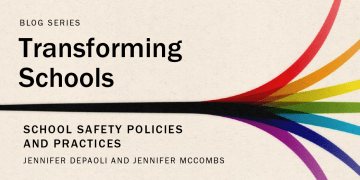Keeping Students Safe: Policies and Practices that Work

This post was originally published on January 25, 2024 by Education Commission of the States.
A rise in the number of school shootings over time has driven increasing attention to school safety, adding to other longstanding concerns about school safety, ranging from fights to bullying. In addition to immediate physical harms, school violence can have long-lasting effects that undermine students’ engagement and mental health. There is widespread agreement that addressing safety threats students may encounter at school should be a priority—something Congress signed off on last year with the passage of the Bipartisan Safer Communities Act. But the policies states might enact to promote safe schools are hotly debated.
In a recent Learning Policy Institute report, we examined the evidence behind different strategies to improve school safety, which fall into two broad approaches: increasing physical security and building supportive school communities.
Strategies to increase physical security include controlling building access and badging staff and visitors, using security cameras and metal detectors, employing school resource officers, and arming school staff. Almost all schools control building access and badge staff and visitors; these strategies have not been studied, likely due to their wide use in other sectors and low cost. Few schools use metal detectors on a daily basis and the evidence does not support expansion. School resource officers have a limited impact on school safety, reducing fights but having no impact on school shootings. Meanwhile, the presence of school resource officers is also associated, on average, with increases in school exclusions, police referrals, and student arrests, actions that have negative consequences for student engagement and academic attainment.
Research also shows that arming staff in K–12 schools can be dangerous, sometimes resulting in unintended shootings from weapons left unattended or accidentally discharged. One study examining intentional school shootings found that controlling for other factors, the presence of armed guards was associated with an increase in the number of casualties.
Building supportive school communities to protect against the perpetration of school violence is increasingly considered an effective school safety strategy. Indeed, strategies such as increasing access to mental health and counseling resources, adopting social and emotional learning practices, implementing restorative practices, and adopting structures and practices that foster strong relationships have been found to significantly reduce school violence and improve school climate.
Unfortunately, while mental health services and counseling have been shown to benefit students and schools, schools' capacity to provide services is strained. On average, public schools have only 1 counselor for every 408 students; and 1 school psychologist for every 1,127 students, and only 42% of schools offer mental health treatment services.
In co-sponsorship with Education Commission of the States and AASA, The School Superintendents Association, LPI hosted a webinar series to learn directly from state and district policymakers, educators, and experts about effective policy approaches and high-impact investments that can help state policymakers, administrators, educators, and others create schools that foster student safety and well-being. The first of these webinars broadly covered how schools can create both physically and psychologically safe learning environments for students, while the second focused on the use of restorative practices to foster supportive school communities.
Key lessons from the brief and webinars suggest that state policymakers who want to improve school safety can:
- Increase student access to mental health and counseling resources. Arizona is using Project AWARE funds to develop mental health service infrastructure; increase youth, family, and school mental health service engagement; and provide training to increase mental health literacy and reduce the stigmas around it.
- Invest in integrated student support systems and community schools to connect students and families to needed supports. For example, in California, significant improvements in school safety have occurred as investments have been made to reduce suspensions, adopt restorative practices, expand mental health programs, and create community schools to ensure students can be more easily connected to needed support services. Kansas launched the Kansans Can School Redesign Project in 2017 to take a more integrated, personalized approach to student learning, build mutually beneficial partnerships with families and communities, and support schools in developing and implementing redesign plans.
- Adopt structures and practices that foster strong relationships. Educators in New York City Schools and Oakland Unified School District shared the positive impacts of creating strong, relationship-centered school communities and investing in restorative practices and called for policymakers to provide resources to support them.
States can also adopt high-impact strategies that:
- Prepare all school staff to better support student well-being. States can support professional learning around student safety and well-being through revisions to educator preparation program approval standards, licensure standard competencies, and in-service professional learning and development. Additionally, states can establish guidance for the appropriate use of school mental health staff, paraprofessionals, and other school staff, as well as criteria for hiring, training, and continuous evaluation of their performance and roles.
- Conduct equity reviews of school safety measures and their impact on discipline outcomes. To identify bias in implementation, schools, districts, and states can review disciplinary action data to track whether school safety measures are associated with increased use of exclusionary discipline and police referrals, particularly for Black students and students with disabilities. States and districts can also support schools in conducting equity reviews to track whether school safety measures have unintended consequences for students.
All children and youth deserve a safe and healthy school environment in which they can learn and thrive, and with meaningful investments using the new influx of federal funds, states and school districts have an opportunity to foster safer schools and adopt research-backed supports and interventions that can create the safe and caring school environments students need.
